Numerical Simulation of 3D Flow Structure and Turbulence Characteristics near Permeable Spur Dike in Channels with Varying Sinuosities
Abstract
:1. Introduction
2. Model Introduction
2.1. Numerical Model Governing Equations
2.1.1. RNG k-ε Model
2.1.2. Volume of Fluid (VOF) Model
2.2. Numerical Model
2.3. Physical Model
2.4. Numerical Model Validation
3. Results
3.1. Mean Flow Pattern
3.2. Strength of Secondary Flow
3.3. Turbulent Kinetic Energy
4. Discussion
5. Conclusions
Author Contributions
Funding
Institutional Review Board Statement
Informed Consent Statement
Data Availability Statement
Conflicts of Interest
References
- Bernhardt, E.S.; Palmer, M.A.; Allan, J.D.; Alexander, G.; Barnas, K.; Brooks, S.; Carr, J.; Clayton, S.; Dahm, C.; Follstad-Shah, J. Synthesizing U.S. River Restoration Efforts. Science 2005, 308, 636–637. [Google Scholar] [CrossRef] [PubMed]
- Iqbal, S.; Pasha, G.A.; Ghani, U.; Ullah, M.K.; Ahmed, A. Flow Dynamics Around Permeable Spur Dike in a Rectangular Channel. Arab. J. Sci. Eng. 2021, 46, 4999–5011. [Google Scholar] [CrossRef]
- Gu, Z.P.; Akahori, R.; Ikeda, S. Study on the Transport of Suspended Sediment in an Open Channel Flow with Permeable Spur Dikes. Int. J. Sediment. Res. 2011, 26, 96–111. [Google Scholar] [CrossRef]
- Ettema, R.; Kirkil, G.; Muste, M. Similitude of Large-Scale Turbulence in Experiments on Local Scour at Cylinders. J. Hydraul. Eng. 2006, 132, 33–40. [Google Scholar] [CrossRef]
- Kuhnle, R.A.; Alonso, C.V.; Shields, F.D. Geometry of Scour Holes Associated with 90 Spur Dikes. J. Hydraul. Eng. 1999, 125, 972–978. [Google Scholar] [CrossRef]
- Hu, J.; Wang, G.; Wang, P.; Yu, T.; Chen, H. Experimental Study on the Influence of New Permeable Spur Dikes on Local Scour of Navigation Channel. Sustainability 2022, 15, 570. [Google Scholar] [CrossRef]
- Nayyer, S.; Farzin, S.; Karami, H.; Rostami, M. A Numerical and Experimental Investigation of the Effects of Combination of Spur Dikes in Series on a Flow Field. J. Braz. Soc. Mech. Sci. 2019, 41, 256. [Google Scholar] [CrossRef]
- Rajaratnam, N.; Nwachukwu, B. Erosion near Groyne-Like Structures. J. Hydraul. Res. 1983, 21, 277–287. [Google Scholar] [CrossRef]
- Przedwojski, B. Bed Topography and Local Scour in Rivers with Banks Protected by Groynes. J. Hydraul. Res. 1995, 33, 257–273. [Google Scholar] [CrossRef]
- Ettema, R.; Muste, M. Scale Effects in Flume Experiments on Flow around a Spur Dike in Flatbed Channel. J. Hydraul. Eng. 2004, 130, 635–646. [Google Scholar] [CrossRef]
- Fazli, M.; Ghodsian, M.; Neyshabouri, S.A. Scour and Flow Field around a Spur Dike in a 90° bend. Int. J. Sediment. Res. 2008, 23, 56–68. [Google Scholar] [CrossRef]
- Kothyari, U.C.; Raju, K.G.R. Scour around Spur Dikes and Bridge Abutments. J. Uydraul. Res. 2001, 39, 367–374. [Google Scholar] [CrossRef]
- Kuhnle, R.A.; Alonso, C.V.; Shields, F.D. Local Scour Associated with Angled Spur Dikes. J. Hydraul. Eng. 2002, 128, 1087–1093. [Google Scholar] [CrossRef]
- Ikeda, S.; Sugimoto, T.; Yoshiike, T. Study on the Characteristics of Flow in Channels with Impermeable Spur Dikes. Proc. JSCE 2000, 656, 145–155. [Google Scholar] [CrossRef] [PubMed]
- Haghnazar, H.; Hashemzadeh Ansar, B.; Asadzadeh, F.; Salehi Neyshabouri, A.A. Experimental Study on the Effect of Single Spur Dike with Slope Sides on Local Scour Pattern. J. Civ. Eng. Mater. Appl. 2018, 2, 111–120. [Google Scholar]
- Azamathulla, H.M.; Ab Ghani, A.; Zakaria, N.A.; Guven, A. Genetic Programming to Predict Bridge Pier Scour. J. Hydraul. Eng. 2010, 136, 165–169. [Google Scholar] [CrossRef]
- Azamathulla, H.M.; Yusoff, M.A.M. Soft Computing for Prediction of River Pipeline Scour Depth. Neural. Comput. Appl. 2013, 23, 2465–2469. [Google Scholar] [CrossRef]
- Pandey, M.; Lam, W.H.; Cui, Y.G.; Khan, M.A.; Singh, U.K.; Ahmad, Z. Scour around Spur Dike in Sand–Gravel Mixture Bed. Water 2019, 11, 1417. [Google Scholar] [CrossRef]
- Masjedi, A.; Bejestan, M.S.; Moradi, A. Experimental Study on the Time Development of Local Scour at a Spur Dike in a 180° Flume Bend. J. Food Agric. Environ. 2010, 8, 904–907. [Google Scholar]
- Fukuoka, S.; Watanabe, A.; Kawaguchi, H.; Yasutake, Y. A Study of Permeable Groins in Series Installed in a Straight Channel. Proc. Hydraul. Eng. 2000, 44, 1047–1052. [Google Scholar] [CrossRef]
- Li, Z.; Michioku, K.; Maeno, S.; Ushita, T.; Fujii, A. Hydraulic Characteristics of a Group of Permeable Groins Constructed in an Open Channel Flow. J. Appl. Mech. 2005, 8, 773–782. [Google Scholar] [CrossRef]
- Osman, M.A.; Saeed, H.N. Local Scour Depth at the Nose of Permeable and Impermeable Spur Dikes. Univ. Khartoum Eng. J. 2012, 2, 1–9. [Google Scholar]
- Zhou, Y.J.; Qian, S.; Sun, N.N. Application of Permeable Spur Dike in Mountain River Training. In Applied Mechanics and Materials; Trans Tech Publications Ltd.: Stafa, Switzerland, 2014; pp. 236–240. [Google Scholar]
- Elawady, E.; Michiue, M.; Hinokidani, O. Movable Bed Scour around Submerged Spur Dikes. Proc. Hydraul. Eng. 2001, 45, 373–378. [Google Scholar] [CrossRef]
- Nath, D.; Misra, U.K. Experimental Study of Local Scour around Single Spur Dike in an open Channel. Int. Res. J. Eng. Technol. 2017, 4, 2728–2734. [Google Scholar]
- Li, Y.; Altinakar, M. Effects of a Permeable Hydraulic Flashboard Spur Dike on Scour and Deposition Yujian. In World Environmental and Water Resources Congress; ASCE: New York, NY, USA, 2016; pp. 399–409. [Google Scholar]
- El-Raheem, A.; Ali, N.A.; Tominaga, A.; Khodary, S.M. Flow analysis around groyne with different permeability in compound channel flood plains. J. Eng. Sci. 2013, 41, 302–320. [Google Scholar]
- Yun, B.; Yu, T.; Wang, P. Experiment research on energy variation around the permeable spur dike. Sci. Technol. Eng. 2021, 21, 3783–3789. [Google Scholar]
- Fan, X.; He, W.; Zhao, W.; Yan, C. Study on variation law of flow structure of hydraulic flashboard permeable spur dike along with water permeability. Water Resour. Hydropower Eng. 2018, 49, 120–126. [Google Scholar]
- Moreto, J.R.; Reeder, W.J.; Budwig, R.; Tonina, D.; Liu, X.F. Experimentally Mapping Water Surface Elevation, Velocity, and Pressure Fields of an Open Channel Flow Around a Stalk. Geophys. Res. Lett. 2022, 49, e2021GL096835. [Google Scholar] [CrossRef]
- Westerweel, J.; Elsinga, G.E.; Adrian, R.J. Particle Image Velocimetry for Complex and Turbulent Flows. Annu. Rev. Fluid Mech. 2013, 45, 409–436. [Google Scholar] [CrossRef]
- You, H.; Tinoco, R.O. Turbulent Coherent Flow Structures to Predict the Behavior of Particles with Low to Intermediate Stokes Number Between Submerged Obstacles in Streams. Water. Resour. Res. 2023, 59, e2022WR032439. [Google Scholar] [CrossRef]
- He, C.; Taylor, J.N.; Rochfort, Q.; Nguyen, D. A New Portable in Situ Flume for Measuring Critical Shear Stress on River Beds. Int. J. Sediment. Res. 2021, 36, 235–242. [Google Scholar] [CrossRef]
- Koken, M. Coherent Structures around Isolated Spur Dikes at Various Approach Flow Angles. J. Hydraul. Res. 2011, 49, 736–743. [Google Scholar] [CrossRef]
- Koken, M.; Constantinescu, G. An Investigation of the Flow and Scour Mechanisms around Isolated Spur Dikes in a Shallow Open Channel: 1. Conditions corresponding to the initiation of the erosion and deposition process. Water. Resour. Res. 2008, 44, W08406. [Google Scholar] [CrossRef]
- Koken, M.; Constantinescu, G. Flow and Turbulence Structure around a Spur Dike in a Channel with a Large Scour Hole. Water Resour. Res. 2011, 47, W12511. [Google Scholar] [CrossRef]
- Koken, M.; Constantinescu, G. An Investigation of the Dynamics of Coherent Structures in a Turbulent Channel Flow with a Vertical Sidewall Obstruction. Phys. Fluids 2009, 21, 085104. [Google Scholar] [CrossRef]
- Paik, J.; Escauriaza, C.; Sotiropoulos, F. Coherent Structure Dynamics in Turbulent Flows Past in-Stream Structures: Some Insights Gained Via Numerical Simulation. J. Hydraul. Eng. 2010, 136, 981–993. [Google Scholar] [CrossRef]
- Paik, J.; Sotiropoulos, F. Coherent Structure Dynamics Upstream of a Long Rectangular Block at the Side of a Large Aspect Ratio Channel. Phys. Fluids 2005, 17, 115104. [Google Scholar] [CrossRef]
- McCoy, A.; Constantinescu, G.; Weber, L. Exchange Processes in a Channel with Two Vertical Emerged Obstructions. Flow. Turbul. Combust. 2006, 77, 97–126. [Google Scholar] [CrossRef]
- McCoy, A.; Constantinescu, G.; Weber, L. A Numerical Investigation of Coherent Structures and Mass Exchange Processes in Channel Flow with Two Lateral Submerged Groynes. Water. Resour. Res. 2007, 43, W05445. [Google Scholar] [CrossRef]
- McCoy, A.; Constantinescu, G.; Weber, L.J. Numerical Investigation of Flow Hydrodynamics in a Channel with a Series of Groynes. J. Hydraul. Eng. 2008, 134, 157–172. [Google Scholar] [CrossRef]
- Zhang, H.; Nakagawa, H.; Kawaike, K.; Yasuyuki, B. Experiment and Simulation of Turbulent Flow in Local Scour around a Spur Dike. Int. J. Sediment. Res. 2009, 24, 33–45. [Google Scholar] [CrossRef]
- Haider, R.; Qiao, D.S.; Yan, J.; Ning, D.Z.; Pasha, G.A.; Iqbal, S. Flow Characteristics around Permeable Spur Dike with Different Staggered Pores at Varying Angles. Arab. J. Sci. Eng. 2022, 47, 5219–5236. [Google Scholar] [CrossRef]
- Mulahasan, S.; Saleh, M.S.; Muhsun, S.S. Simulation of Flow around a Permeable Dike Using Physical and 3D-CFD Models. Int. J. River Basin Manag. 2021, 21, 53–65. [Google Scholar] [CrossRef]
- Ouillon, S.; Dartus, D. Three-Dimensional Computation of Flow around Groyne. J. Hydraul. Eng. 1997, 123, 962–970. [Google Scholar] [CrossRef]
- Yazdi, J.; Sarkardeh, H.; Azamathulla, H.M.; Ghani, A.A. 3D Simulation of Flow around a Single Spur Dike with Free-Surface Flow. Int. J. River Basin Manag. 2010, 8, 55–62. [Google Scholar] [CrossRef]
- Shukry, A. Flow around Bends in an Open Flume. Trans. Am. Soc. Civ. Eng. 1950, 115, 751–778. [Google Scholar] [CrossRef]
- Kumar, A.; Ojha, C.S.P. Effect of Different Compositions in Unsubmerged L-Head Groynes to Mean and Turbulent Flow Characteristics. KSCE J. Civ. Eng. 2019, 23, 4327–4338. [Google Scholar] [CrossRef]
- Jeon, J.; Lee, J.Y.; Kang, S. Experimental Investigation of Three-Dimensional Flow Structure and Turbulent Flow Mechanisms around a Nonsubmerged Spur Dike with a Low Length-to-Depth Ratio. Water Resour. Res. 2018, 54, 3530–3556. [Google Scholar] [CrossRef]
- Vaghefi, M.; Ahmadi, A.; Faraji, B. Variation of Hydraulic Parameters with Different Wing of a T-Shape Spur Dike in Bend Channels. J. Cent. South Univ. 2018, 25, 671–680. [Google Scholar] [CrossRef]
- Ding, C.; Li, C.; Song, L.; Chen, S. Numerical Investigation on Flow Characteristics in a Mildly Meandering Channel with a Series of Groynes. Sustainability 2023, 15, 4124. [Google Scholar] [CrossRef]

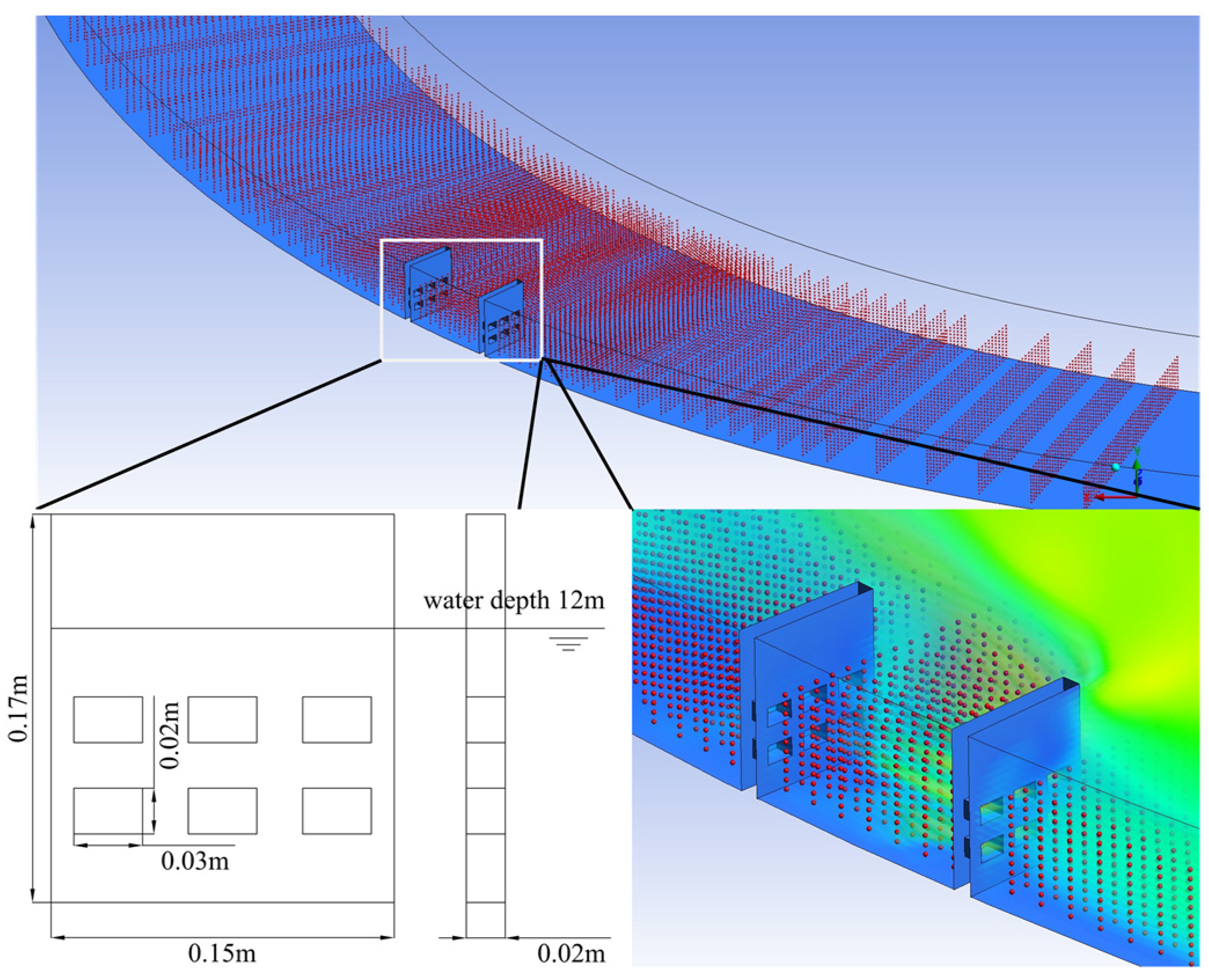
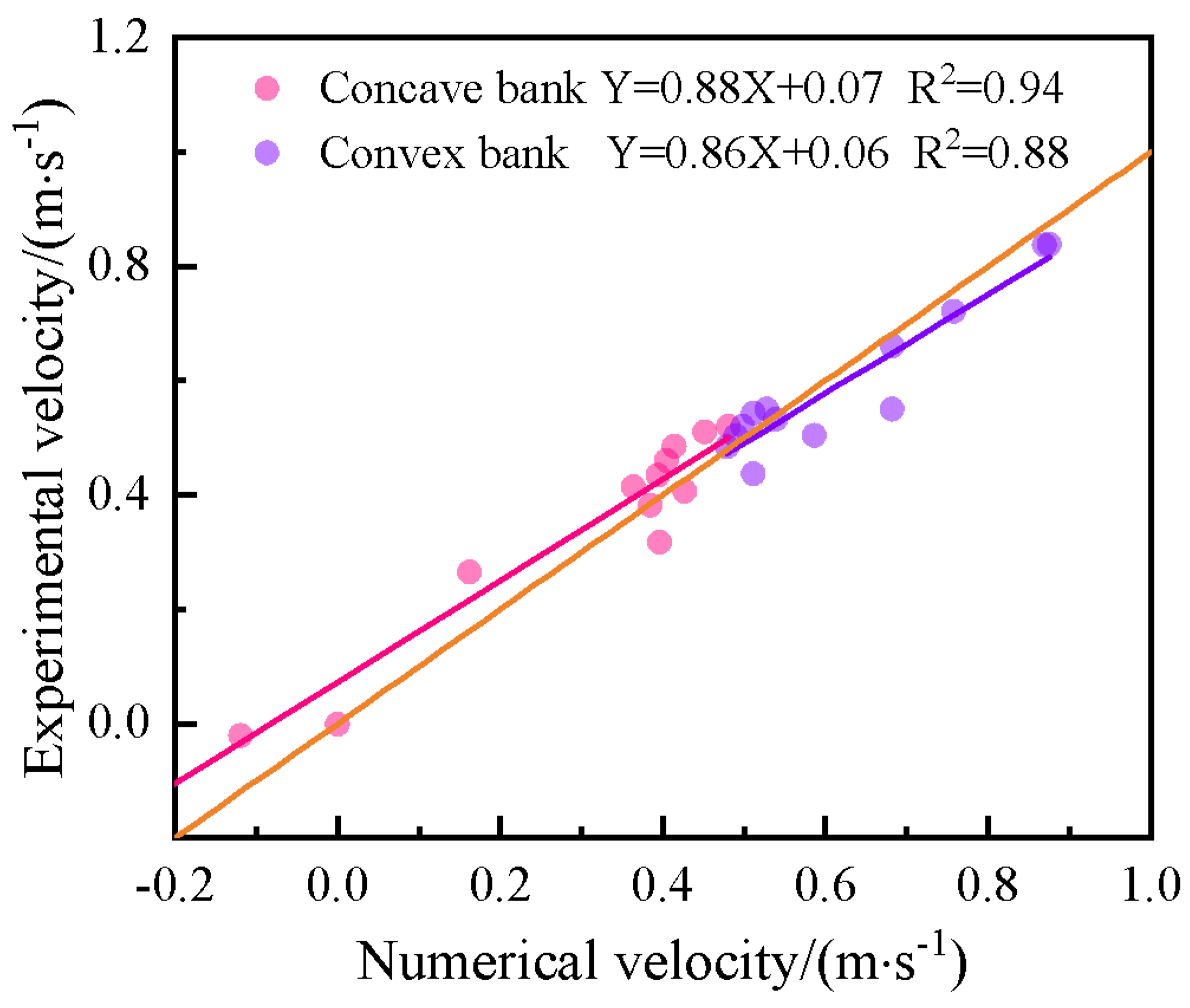
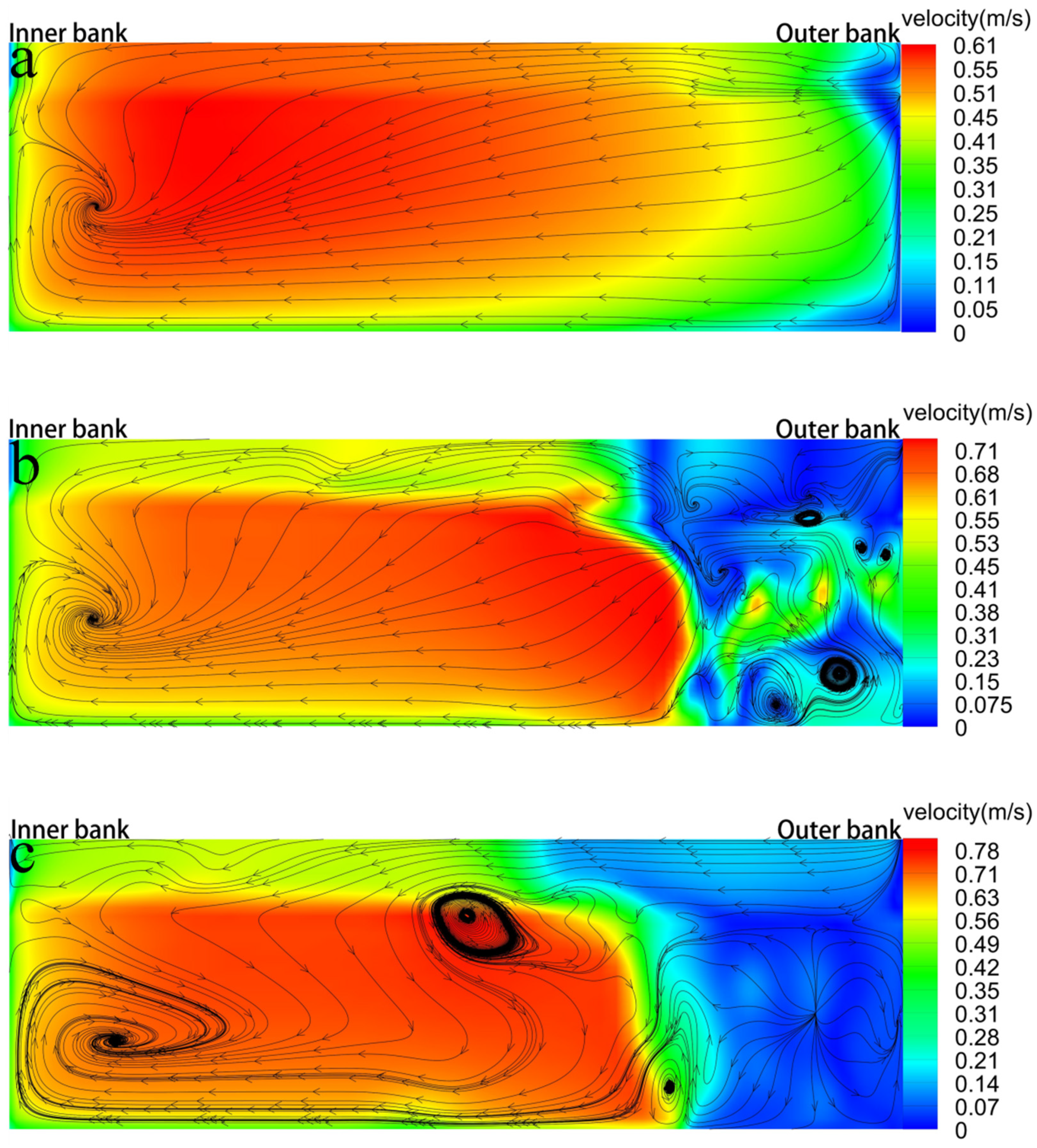
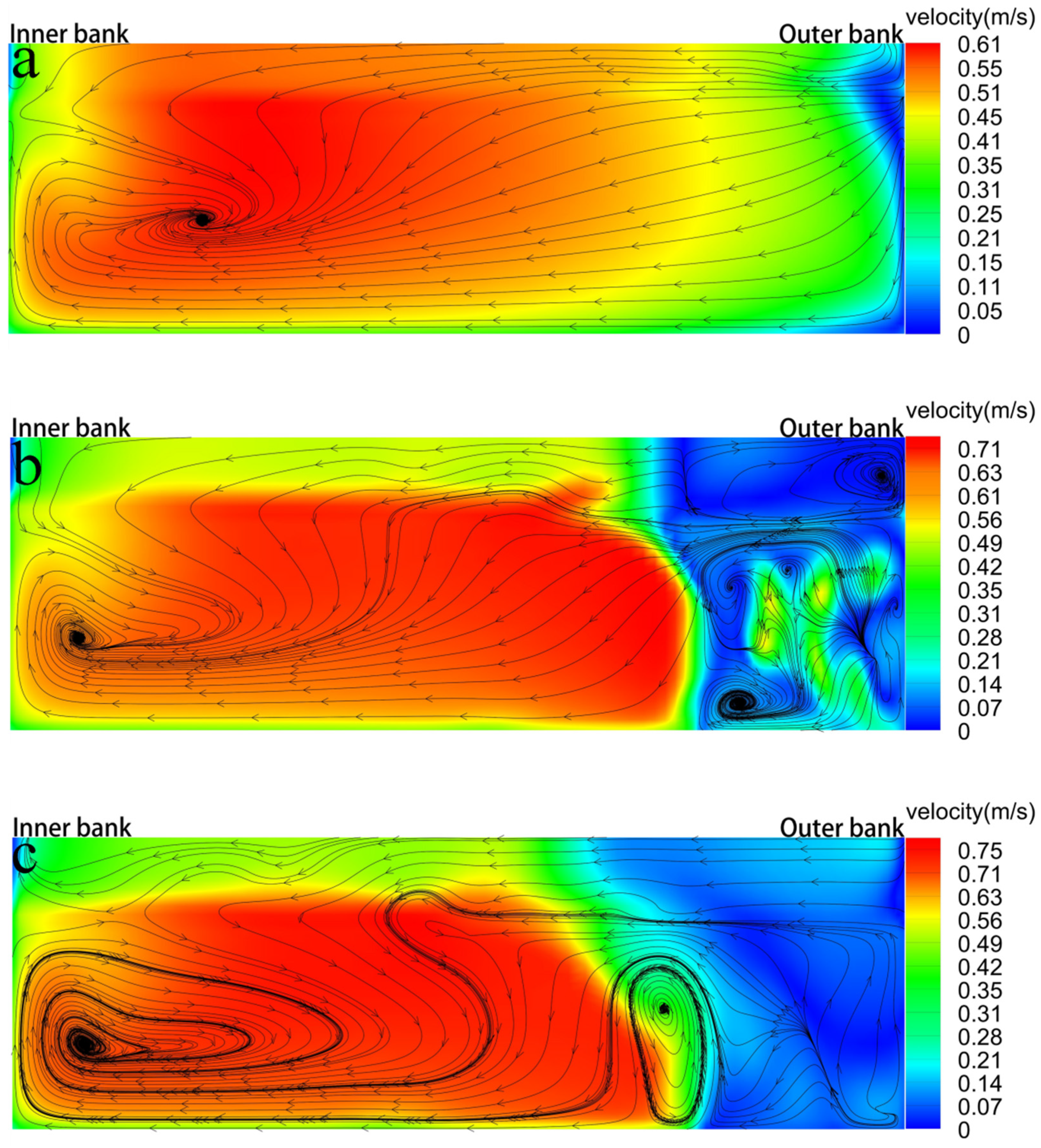



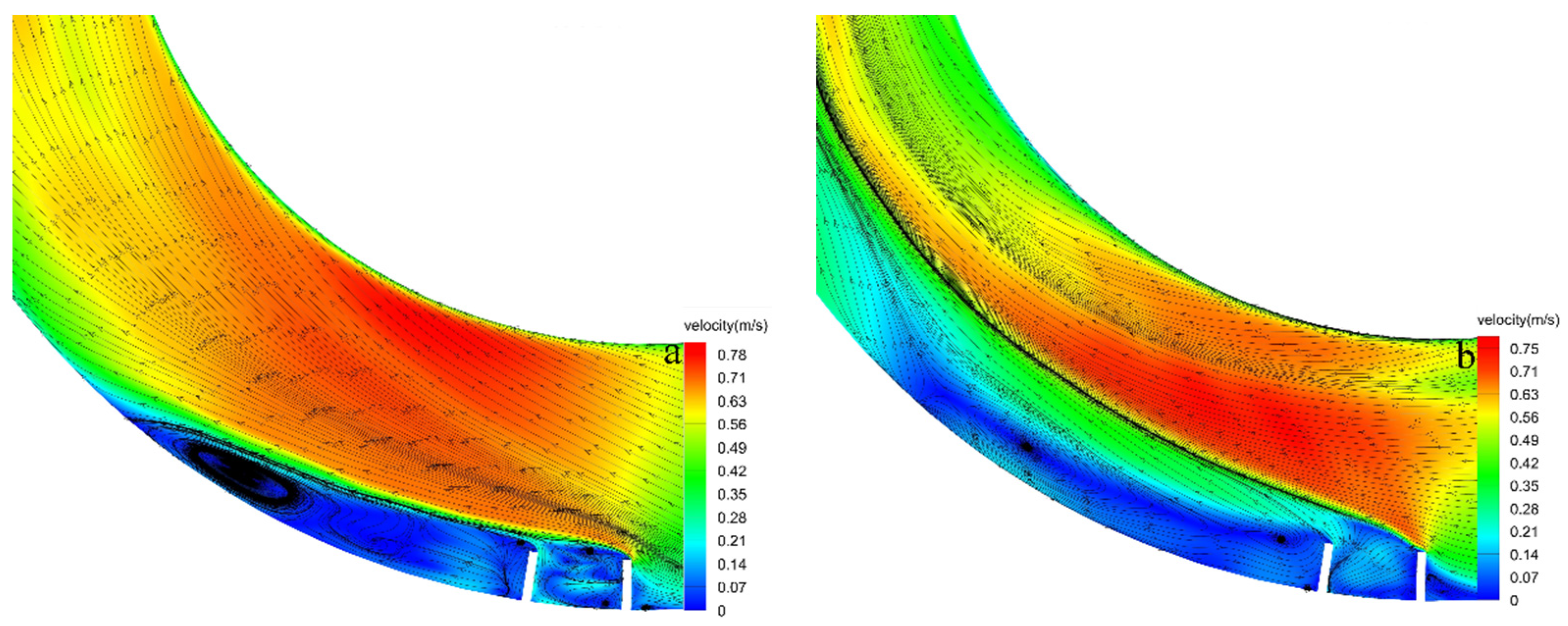
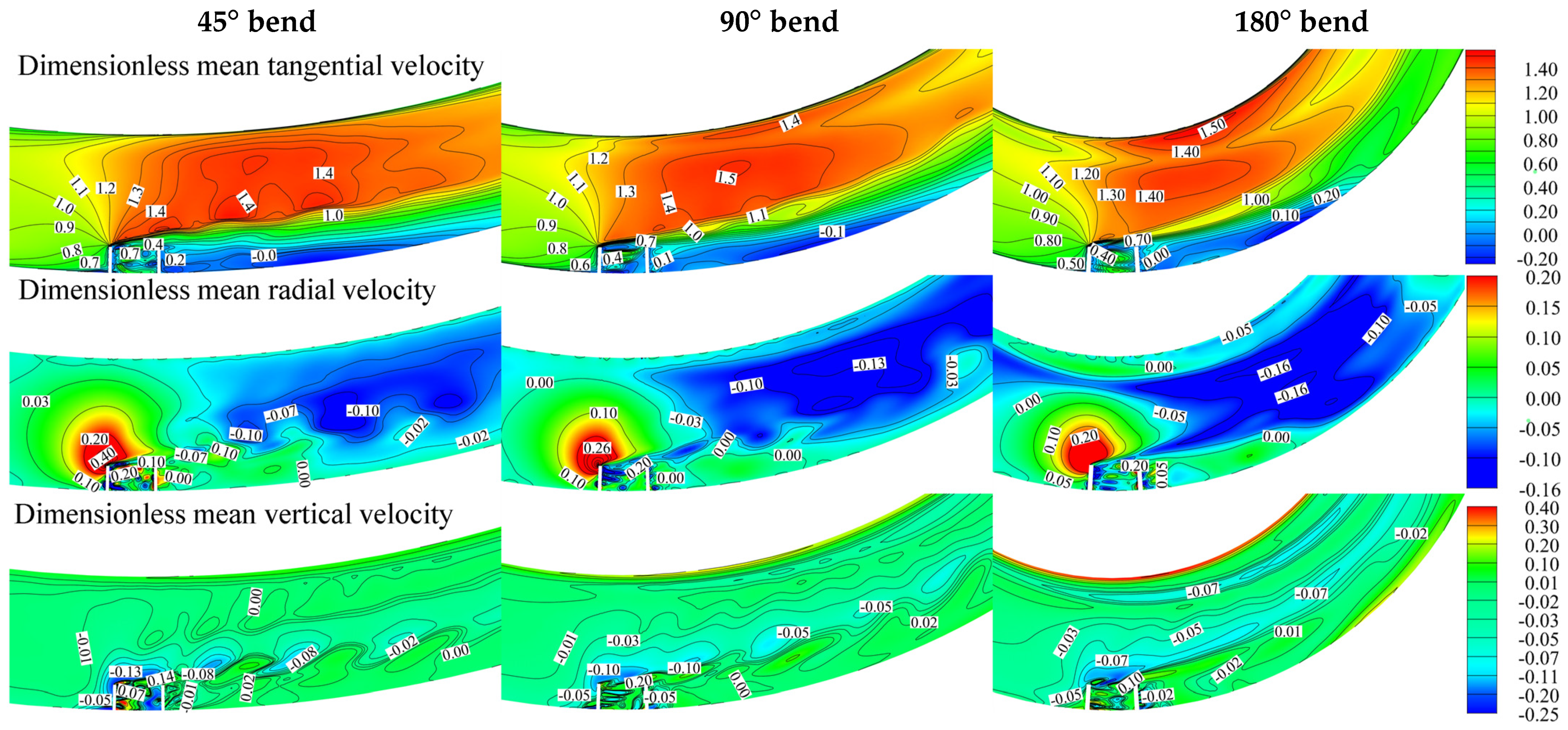
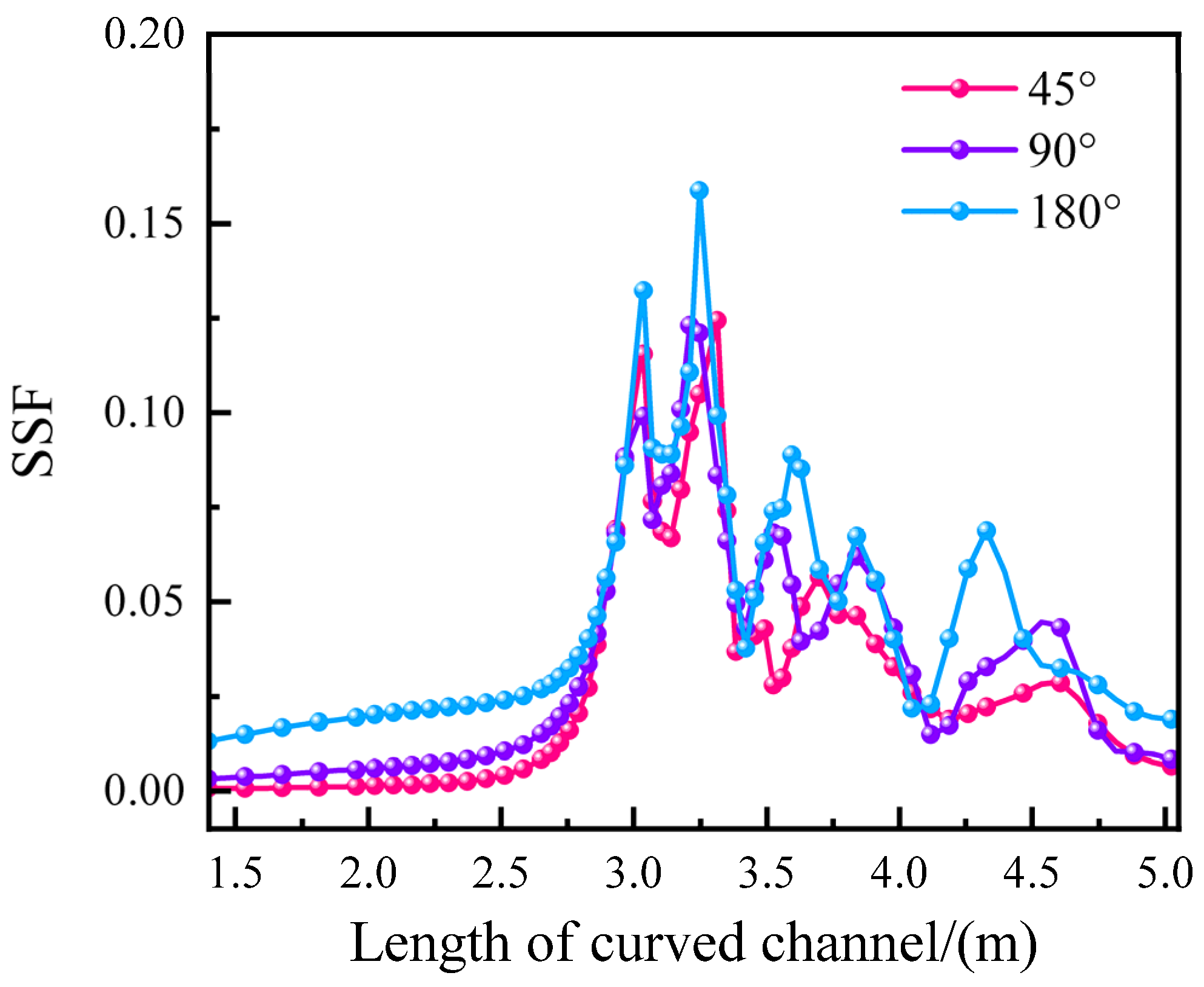
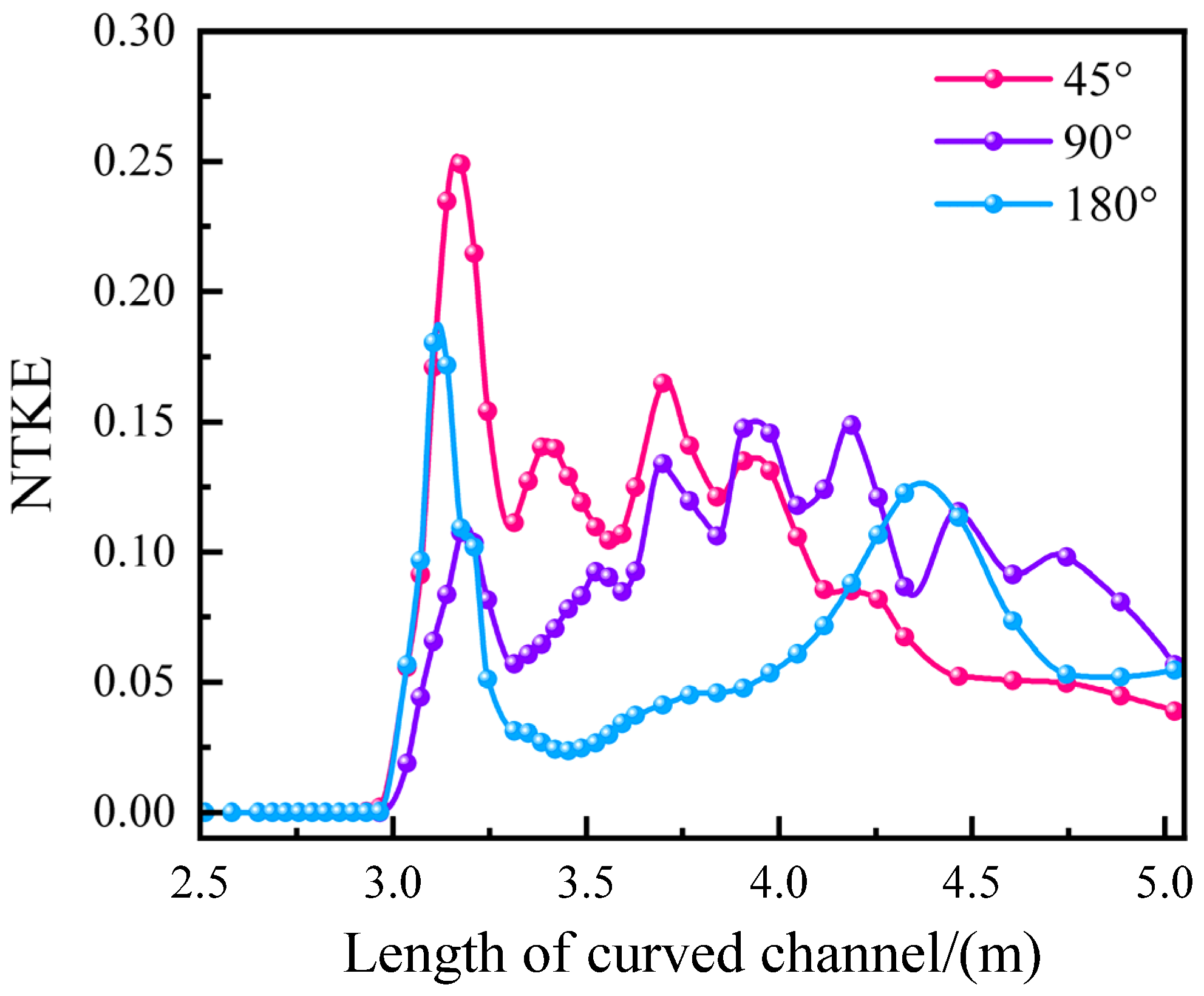
| Experimental Conditions | Case 1 | Case 2 | Case 3 | Case 4 |
|---|---|---|---|---|
| Water depth at tailgate, () | 0.12 | |||
| Flume width, () | 0.8 | |||
| Thickness of spur dike, () | 0.02 | |||
| Radial length of spur dike, () | 0.15 | |||
| Ratio of flume width to tailgate depth, | 6.67 | |||
| Ratio of length to water depth, | 1.25 | |||
| Ratio of spur dike length to flume width, | 0.19 | |||
| Flow volume, () | 0.05 | |||
| Mean velocity, () | 0.52 | |||
| Froude number, | 0.48 | |||
| Temperature, () | 24 | |||
| Kinematic viscosity, () | 0.9 × 10−6 | |||
| Reynolds number, | 6.9 × 104 | |||
| Curve radius, () | 8 | 4 | 2 | 2 |
| Bend type, (°) | 45 | 90 | 180 | 180 |
| Research method | numerical simulation | numerical simulation | numerical simulation | physical investigation |
| Curve Type | Location of Monitoring Points | Number of Monitoring Points | Spacing of Monitoring Points in Downstream Direction (°) | Spacing of Monitoring Points in Radial Direction (m) | Spacing of Monitoring Points in Vertical Direction (m) |
|---|---|---|---|---|---|
| 45° bend | 9°–13° | 2145 | 1° | 0.02 | 0.01 |
| 14°–18.5° | 4290 | 0.5° | |||
| 19°–26° | 11,583 | 0.25° | |||
| 26.5°–31° | 4290 | 0.5° | |||
| 32°–36° | 2145 | 1° | |||
| 90° bend | 18°–26° | 2145 | 2° | ||
| 28°–37° | 4290 | 1° | |||
| 38°–52° | 11,583 | 0.5° | |||
| 53°–62° | 4290 | 1° | |||
| 64°–72° | 2145 | 2° | |||
| 180° bend | 36°–52° | 2145 | 4° | ||
| 56°–74° | 4290 | 2° | |||
| 76°–104° | 11,583 | 1° | |||
| 106°–124° | 4290 | 2° | |||
| 128°–144° | 2145 | 4° |
Disclaimer/Publisher’s Note: The statements, opinions and data contained in all publications are solely those of the individual author(s) and contributor(s) and not of MDPI and/or the editor(s). MDPI and/or the editor(s) disclaim responsibility for any injury to people or property resulting from any ideas, methods, instructions or products referred to in the content. |
© 2023 by the authors. Licensee MDPI, Basel, Switzerland. This article is an open access article distributed under the terms and conditions of the Creative Commons Attribution (CC BY) license (https://creativecommons.org/licenses/by/4.0/).
Share and Cite
Xie, P.; Li, C.; Lv, S.; Zhang, F.; Jing, H.; Li, X.; Liu, D. Numerical Simulation of 3D Flow Structure and Turbulence Characteristics near Permeable Spur Dike in Channels with Varying Sinuosities. Sustainability 2023, 15, 15862. https://doi.org/10.3390/su152215862
Xie P, Li C, Lv S, Zhang F, Jing H, Li X, Liu D. Numerical Simulation of 3D Flow Structure and Turbulence Characteristics near Permeable Spur Dike in Channels with Varying Sinuosities. Sustainability. 2023; 15(22):15862. https://doi.org/10.3390/su152215862
Chicago/Turabian StyleXie, Peng, Chunguang Li, Suiju Lv, Fengzhu Zhang, Hefang Jing, Xiaogang Li, and Dandan Liu. 2023. "Numerical Simulation of 3D Flow Structure and Turbulence Characteristics near Permeable Spur Dike in Channels with Varying Sinuosities" Sustainability 15, no. 22: 15862. https://doi.org/10.3390/su152215862
APA StyleXie, P., Li, C., Lv, S., Zhang, F., Jing, H., Li, X., & Liu, D. (2023). Numerical Simulation of 3D Flow Structure and Turbulence Characteristics near Permeable Spur Dike in Channels with Varying Sinuosities. Sustainability, 15(22), 15862. https://doi.org/10.3390/su152215862





